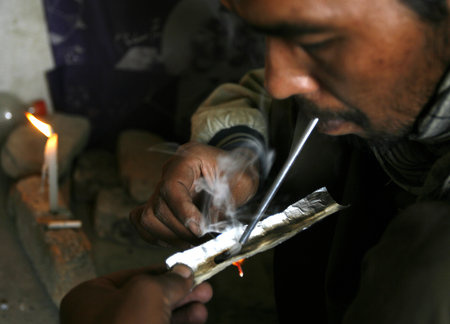Alarming Percentages of Women Drug Users in the N-E
N-E India is infamous for drug abuse

NEW DELHI: North-East India is quite notorious for its availability and usage of banned drugs and considered a haven for drug consumers, particularly opium, owing to its proximity to the Golden Triangle – Asia’s main opium producing area. A recent study by the United Nations on women drug users in the North East has brought into light some hair- raising statistics.
The study “Women Who Use Drugs in Northeast India” , commissioned by the United Nations Office on Drugs and Crime (UNODC) under its regional initiative ‘Prevention of transmission of HIV amongst drug users in SAARC Countries’ is the first comprehensive study of women who use drugs across all the eight states of the North East and has produced alarming results.
Drug consumption is quite pervasive amongst the women of the region, with as many as 28.2 % of women using drugs in Manipur, 17.4 % in Mizoram, 14.9% in Nagaland while 12.1% of women consumed drugs in Meghalaya, 10.2% in Assam and Sikkim had 9.8% share.
Further, the study also noted “A household survey in one found that 2.1 per cent of females were opium users” and that “a majority of them were introduced to opium by their husbands after marriage.”
Analysing substance abuse amongst women, the 108-page report released in New Delhi read “substance use among women is associated with early initiation to sex, sexual abuse, greater number of sexual partners, exchange of money for sex, and infrequent use of condoms with sexual partners”. It further pointed out that among more than half of the women drug users, the prime source of income was through selling drugs or sex.
The study which interviewed 1,150 women who use drugs in the region concluded that physical violence is very common among women who use drugs, with nearly two-thirds of the participants having been hit with a fist or kicked or beaten, at least once or more. Moreover, the incidence of physical violence and abuse with a frequency of once or more were by a range of people- non-sex partners (62%), sex partners (54%) , community/ neighbours (28%), police (27%) and casual sex partners (26%).
What is further harrowing is the fact that most women are unaware of the perils of substance abuse , particularly the possible dangerous infections and diseases one might catch. “The worrisome finding is that in 44.9 per cent of these cases, the first injection is through a used needle. HIV/AIDS is not a concern for most persons while injecting for the first time, with about two-thirds (65.2 per cent) not thinking about HIV at the time of the first injection and only a very small proportion (6.6 per cent) believing that HIV is probable and very likely because of injecting drugs”, the report said.
The study calculated that the median age of initiation of tobacco, alcohol and other substances is 16, 17 and 20 years, respectively. Among nearly two-thirds of the women, the first drug used other than tobacco/ alcohol is an opioid- either proxyvon or heroin. A little more than a third of the women who use drugs admit to a pathological pattern of alcohol use, and concurrent use of cannabis is reported by 35 per cent.
The report says societal pressure, changing roles, increased stress and alterations in lifestyle are making women in the country vulnerable to newer problems.
"As is true for all societies, women in the northeastern states are vulnerable to these changes. However, the lack of opportunities and development, and given the geographical proximity of these states to areas from where opioids and psychotropic drugs are sourced, makes women in Northeast India doubly vulnerable," it says.
The key reasons of drug abuse were reported as greater euphoria, curiosity and peer influence.
The study also recommended a multi-disciplinary approach to address the key concerns of women who use drugs. It suggested that women-centric targeted interventions need to be expanded in high HIV-burden states and immediately established in low HIV-burden states, along with other propositions.



